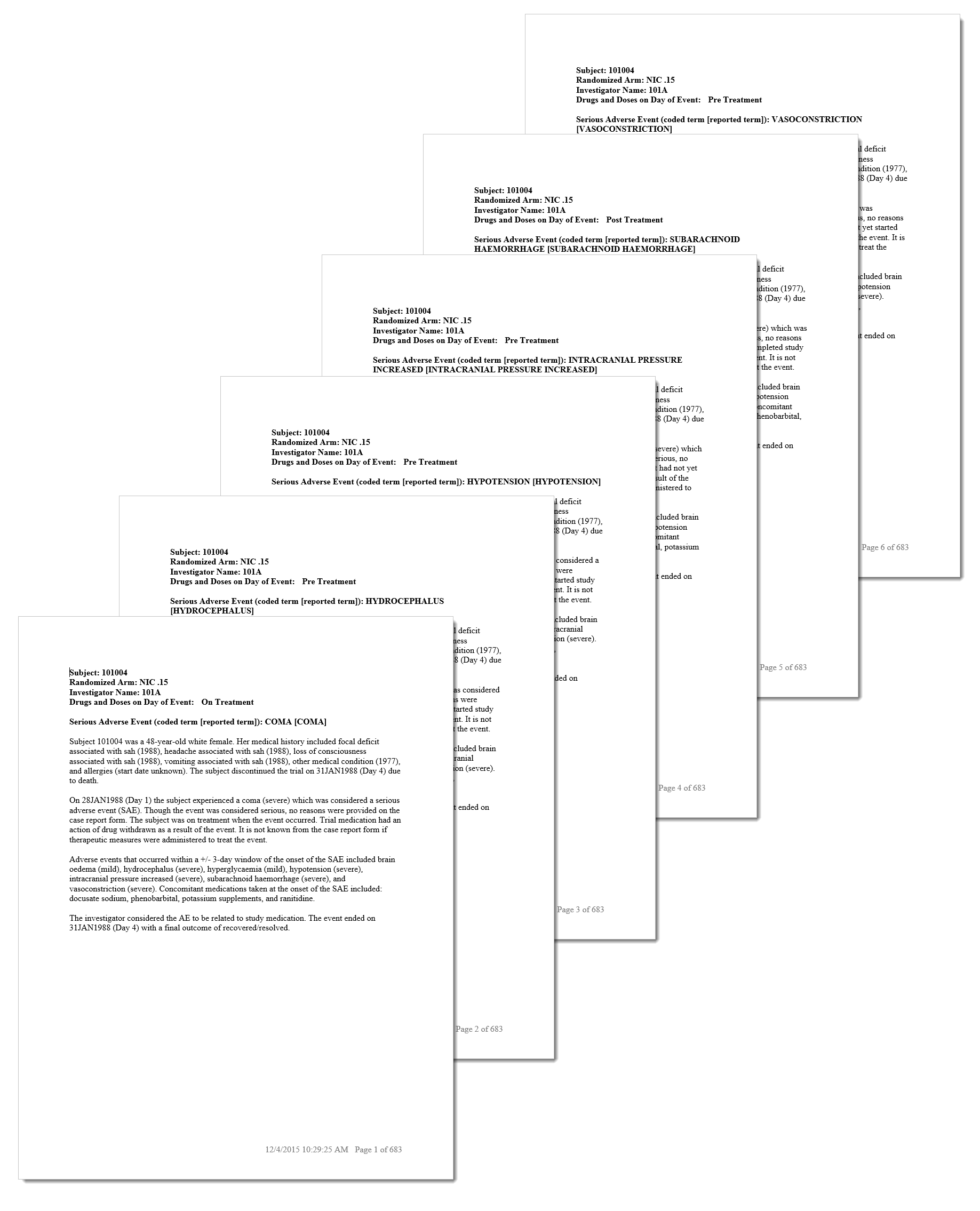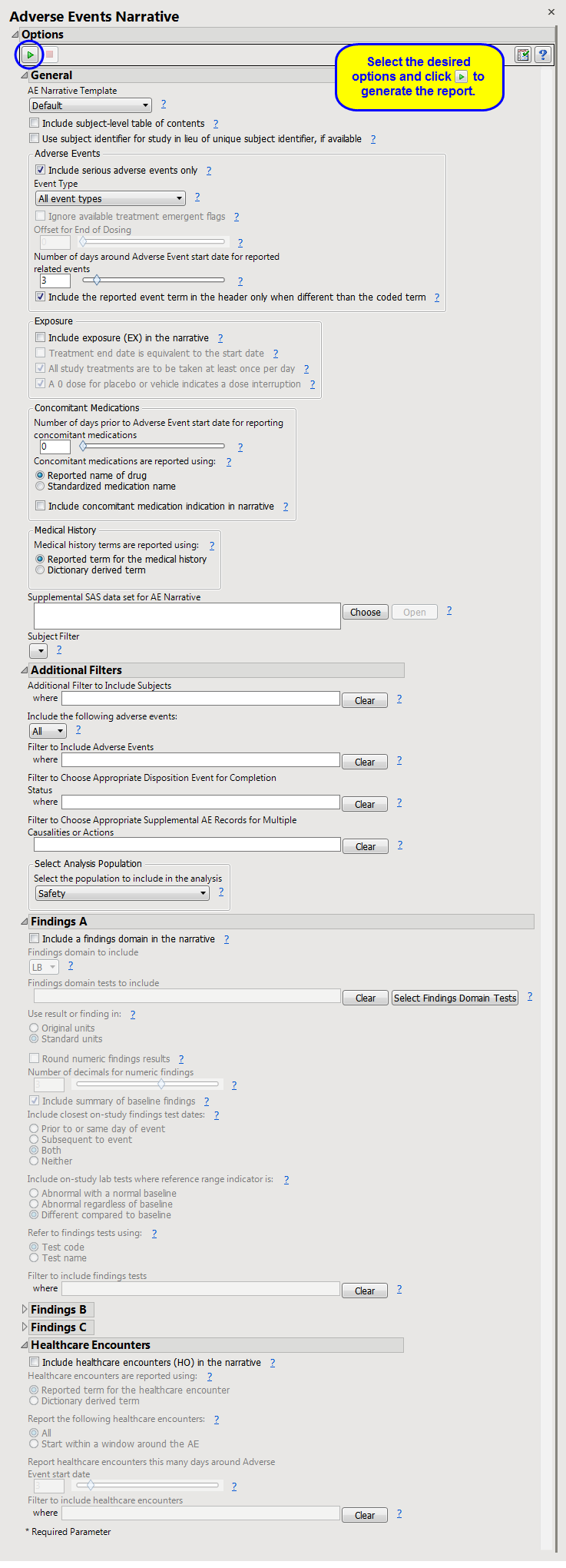This report is used to generate
AE
narratives for clinical study reports.
Running this report with the
Nicardipine
sample setting generates an
rtf
file containing narratives like the one below.
|
•
|
When a partial date identified (
xxDTC
for
LB
,
EG
or
VS
), an asterisk (*) is appended to the end of the finding name or test code. You should review the findings for the appropriately reported set of observations.
|
|
•
|
When the reference date (
RFSTDTC
) is partial, an asterisk is appended to the
AETERM
. You should review all reported dates, study days, and contents for correctness.
|
|
•
|
When the AE start date (
AESTDTC
) is partial, an asterisk is appended to the date in the narrative. You should review all contents of the narrative.
|
|
•
|
When the AE end date (
AEENDTC
) is partial, an asterisk is appended to the date in the narrative. You should review the final outcome and narrative header information for correctness.
|
|
•
|
When any of the dosing records have partial dates for
exstdtc
or
exendtc
, an asterisk is placed in the drug header that explains dose at time of the event, or the pre- or post-dose status. All text related to the drug should be reviewed.
|
|
•
|
When the date of completion or discontinuation (
DSSTDTC
) is partial, an asterisk is appended to the date in the narrative. You should review these dates for correctness.
|
|
•
|
When either or both of the start or stop dates (
CMSTDTC
or
CMENDTC
) for Concomitant medications are partial, an asterisk is appended to the end of
CMTERM
or
CMDECOD
(based on the selected analysis option). You should review the data for this medication for correctness.
|
Paragraph 1
summarizes demographic and medical history. You have the option to include reported or coded medical history terms. The first exposure to study drug is reported as well as the subject's completion status. The appropriate disposition term from DS should be provided on the
General
tab of the
AE Narrative
dialog
.
Paragraph 2
describes the particular AE of interest, such as the date of occurrence, whether it met the definition of serious or not and the particular criteria (all non-serious AEs are considered
Other Significant Adverse Events
) and the action taken with study medication as the result of the event. Other details include the dose of drug taken at the time of the event and how long the subject was at this dose. If the event occurred between the first and last day of dosing (inclusive), and a subject received a dose of 0 or no drug taken at the time, then this is considered a dose interruption. Events before the first day of dosing are considered "Pre-treatment", while those after the last day of dosing are considered "Post-treatment". If a subject has no records in EX with a dose >
0
, then they are considered "Untreated". If more than one dose is taken on the day on which the event begins, the maximum is reported. Concomitant medications were used to treat the event are reported (based on
AECONTRT
). Should
AECONTRT
=
Y
, the narrative code attempts to identify these medications by looking for medications with indications that match the reported term of the event.
Paragraph 3
reports on other
adverse events
that occur close to the start of the event of interest. The
severity
or
toxgrade
of these events are reported. Only unique instances based on AE term and severity are printed. For example, if a subject has two mild headaches in a six-day , this is printed only
once
. Any medications that are taken at the time of the event are reported. The
Options
tab enables you to include the indication for each medication. Similar to the reporting of nearby AEs, only unique concomitant medications (and indications, if requested) are reported.
Paragraphs 4-6
(if requested from the
Labs
, ECG, or
Vital Signs
sections) provide a brief description of findings results that provide further insight to the adverse event. Baseline findings can be included to understand how a subject began the study. Baseline flags reported in the data are considered for defining baseline. Otherwise, the program determines baseline (of
all
records, or those
flagged as baseline
from the data). For laboratory measurements, the last measurement on or before the start of dosing (day 1) is considered baseline. For ECG and Vital Signs, the last day of measurements on or before the start of dosing (day 1) is considered baseline. If multiple measurements are reported on this day, all measurements are reported. You also have the ability to report on post-baseline findings that occur on, before, or after the event. Findings reporting can be customized using
WHERE statements
(see
The SAS WHERE Expression
) or the
option to subset those tests or results that are of interest.
The
final paragraph
describes the causal effect of the study medication to the AE and whether the event was resolved.
Note
: Microsoft Word is the only supported word processor for viewing Adverse Events narratives. You might need to set Microsoft Word as your default word processor to prevent other word processors from opening the narratives.
Note
: For information about how treatment emergent adverse events (TEAEs) are defined in JMP Clinical, please refer to
How does JMP Clinical determine whether an Event Is a Treatment Emergent Adverse Event?
.
Note
: For information about how incomplete or missing date and time information is handled by JMP Clinical, please refer to
How does JMP Clinical handle partial or incomplete date and time information?
.
AE Narrative Template
,
Include subject-level table of contents
,
Use subject identifier for study in lieu of unique subject identifier, if available
Adverse Events
:
Include serious adverse events only
,
Event Type
,
Ignore available treatment emergent flags
,
Offset for End of Dosing
,
Number of days around Adverse Event start date for reported related events
,
Include the reported event term in the header only when different than the coded term
Exposure
:
Include exposure (EX) in the narrative
,
Treatment end date is equivalent to the start date
,
All study treatments are to be taken at least once per day
,
A 0 dose for placebo or vehicle indicates a dose interruption
Concomitant Medications
:
Number of days prior to Adverse Event start date for reporting concomitant medications
,
Concomitant medications are reported using:
,
Include concomitant medication indication in narrative
Include the following adverse events:
,
Filter to Include Adverse Events
,
Filter to Choose Appropriate Disposition Event for Completion Status
,
Filter to choose Appropriate Supplemental AE Records for Multiple Causalities or Actions
Include a findings domain in the narrative
,
Findings domain to include
,
Findings domain tests to include
,
Use result or finding in:
,
Round numeric findings results
,
Number of decimals for numeric findings
,
Include summary of baseline findings
,
Include closest on-study findings test dates:
,
Include on-study lab tests where reference range indicator is:
,
Refer to findings tests using:
,
Filter to Include Findings Tests
,
Include healthcare encounters (HO) in the narrative
Healthcare encounters are reported using:
,
Report the following healthcare encounters:
,
Report healthcare encounters this many days around Adverse Event start date:
,
Filter to Include Healthcare Encounters
Subject-specific filters must be created using the
Create Subject Filter
report prior to your analysis.
For more information about how to specify a filter using this option, see
The SAS WHERE Expression
.

